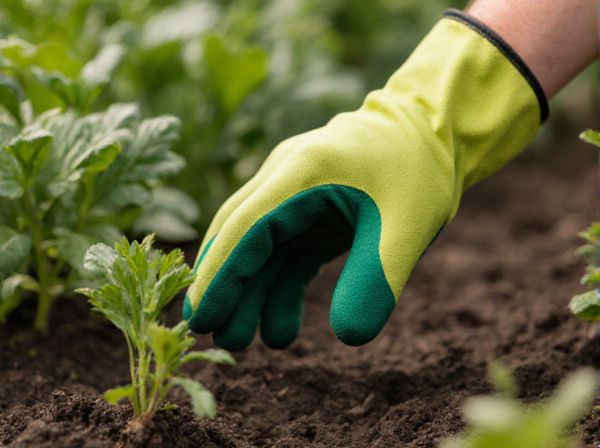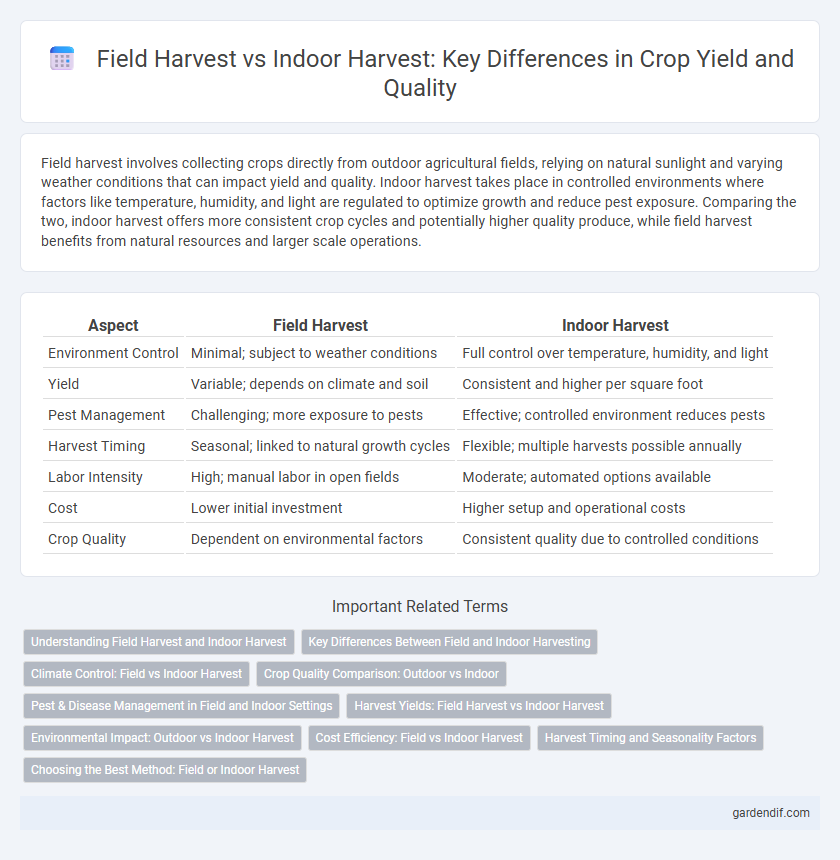
Field Harvest vs Indoor Harvest Illustration
Field harvest involves collecting crops directly from outdoor agricultural fields, relying on natural sunlight and varying weather conditions that can impact yield and quality. Indoor harvest takes place in controlled environments where factors like temperature, humidity, and light are regulated to optimize growth and reduce pest exposure. Comparing the two, indoor harvest offers more consistent crop cycles and potentially higher quality produce, while field harvest benefits from natural resources and larger scale operations.
Table of Comparison
| Aspect | Field Harvest | Indoor Harvest |
|---|---|---|
| Environment Control | Minimal; subject to weather conditions | Full control over temperature, humidity, and light |
| Yield | Variable; depends on climate and soil | Consistent and higher per square foot |
| Pest Management | Challenging; more exposure to pests | Effective; controlled environment reduces pests |
| Harvest Timing | Seasonal; linked to natural growth cycles | Flexible; multiple harvests possible annually |
| Labor Intensity | High; manual labor in open fields | Moderate; automated options available |
| Cost | Lower initial investment | Higher setup and operational costs |
| Crop Quality | Dependent on environmental factors | Consistent quality due to controlled conditions |
Understanding Field Harvest and Indoor Harvest
Field harvest involves gathering crops directly from outdoor agricultural fields, where factors such as weather conditions, soil quality, and seasonal timing significantly impact yield and crop quality. Indoor harvest occurs in controlled environments like greenhouses or vertical farms, allowing for year-round production with optimized light, temperature, and humidity levels to enhance plant growth and consistency. Comparing these methods highlights that field harvest depends heavily on natural elements, while indoor harvest leverages technology to mitigate environmental risks and improve predictability.
Key Differences Between Field and Indoor Harvesting
Field harvest relies on natural sunlight and weather conditions, making crop yields subject to seasonal variations and environmental risks. Indoor harvesting utilizes controlled environments with artificial light, temperature, and humidity regulation, ensuring consistent growth cycles and higher productivity. Equipment and labor requirements also differ, with field harvesting demanding large-scale machinery, while indoor operations often use automated systems for precision and efficiency.
Climate Control: Field vs Indoor Harvest
Climate control plays a crucial role in optimizing harvest outcomes; field harvests depend heavily on natural weather patterns, which can lead to unpredictable moisture levels and crop quality. Indoor harvests benefit from precise climate regulation, allowing control over temperature, humidity, and light, resulting in consistent crop development and reduced risk of disease. This controlled environment enhances yield predictability and extends growing seasons compared to traditional field harvesting.
Crop Quality Comparison: Outdoor vs Indoor
Field harvest often results in crops with more robust flavors and natural resilience due to exposure to sunlight and varying weather conditions, which enhances nutrient density and terpene profiles. Indoor harvest provides precise control over environmental factors such as humidity, temperature, and light cycles, leading to consistently higher-quality crops with minimal pest damage and uniform appearance. However, indoor-grown produce can sometimes lack the complex flavor nuances found in field-harvested crops, which benefit from natural stressors and soil microbiomes.
Pest & Disease Management in Field and Indoor Settings
Field harvests face greater challenges with pest and disease management due to exposure to diverse environmental factors and wild pests, requiring regular monitoring and use of biological controls or pesticides. Indoor harvests benefit from controlled environments that limit pest entry and reduce disease incidence, enabling more precise integrated pest management strategies and reduced chemical use. Effective pest and disease management strategies in both settings are crucial for maximizing crop yields and ensuring quality during harvest.
Harvest Yields: Field Harvest vs Indoor Harvest
Field harvests typically yield lower quantities per square meter due to environmental variability and pest exposure, while indoor harvests achieve higher yields through controlled conditions, optimized lighting, and precise nutrient management. Indoor cultivation allows for year-round harvesting cycles, significantly increasing total annual yield compared to seasonal outdoor field harvests. Advances in vertical farming and hydroponics enhance indoor harvest efficiency, resulting in 3 to 10 times greater yields per unit area than traditional field harvest methods.
Environmental Impact: Outdoor vs Indoor Harvest
Field harvests leverage natural sunlight and rainwater, significantly reducing energy consumption and water usage compared to indoor harvests that rely heavily on artificial lighting and climate control systems. Outdoor farming supports biodiversity and soil health by maintaining natural ecosystems, whereas indoor harvests often require substantial energy inputs for ventilation, heating, and cooling, increasing carbon footprints. While indoor harvests can optimize yield per square foot, their environmental impact is typically higher due to resource-intensive infrastructure and energy demands.
Cost Efficiency: Field vs Indoor Harvest
Field harvests generally offer greater cost efficiency due to lower setup and operational expenses, relying on natural sunlight and open land which reduces energy costs. Indoor harvests involve higher initial investments in infrastructure, lighting, and climate control systems, resulting in elevated ongoing operational costs. However, indoor cultivation can maximize yield per square foot and ensure consistent year-round production, partially offsetting the higher expenses.
Harvest Timing and Seasonality Factors
Harvest timing and seasonality factors differ significantly between field harvest and indoor harvest methods. Field harvests rely heavily on natural growing seasons, climate conditions, and daylight hours, which dictate planting and picking schedules to maximize crop yield and quality. Indoor harvests benefit from controlled environments, allowing for multiple growth cycles annually and precise timing independent of outdoor seasonal changes.
Choosing the Best Method: Field or Indoor Harvest
Choosing between field harvest and indoor harvest depends on crop type, climate conditions, and resource availability. Field harvest suits large-scale, drought-resistant crops like wheat and corn with natural sunlight, while indoor harvest allows precise environmental control for high-value plants such as herbs and vegetables. Indoor harvesting optimizes yield quality and reduces pest risk, whereas field harvest maximizes output at lower operational costs.
Field Harvest vs Indoor Harvest Infographic

 gardendif.com
gardendif.com